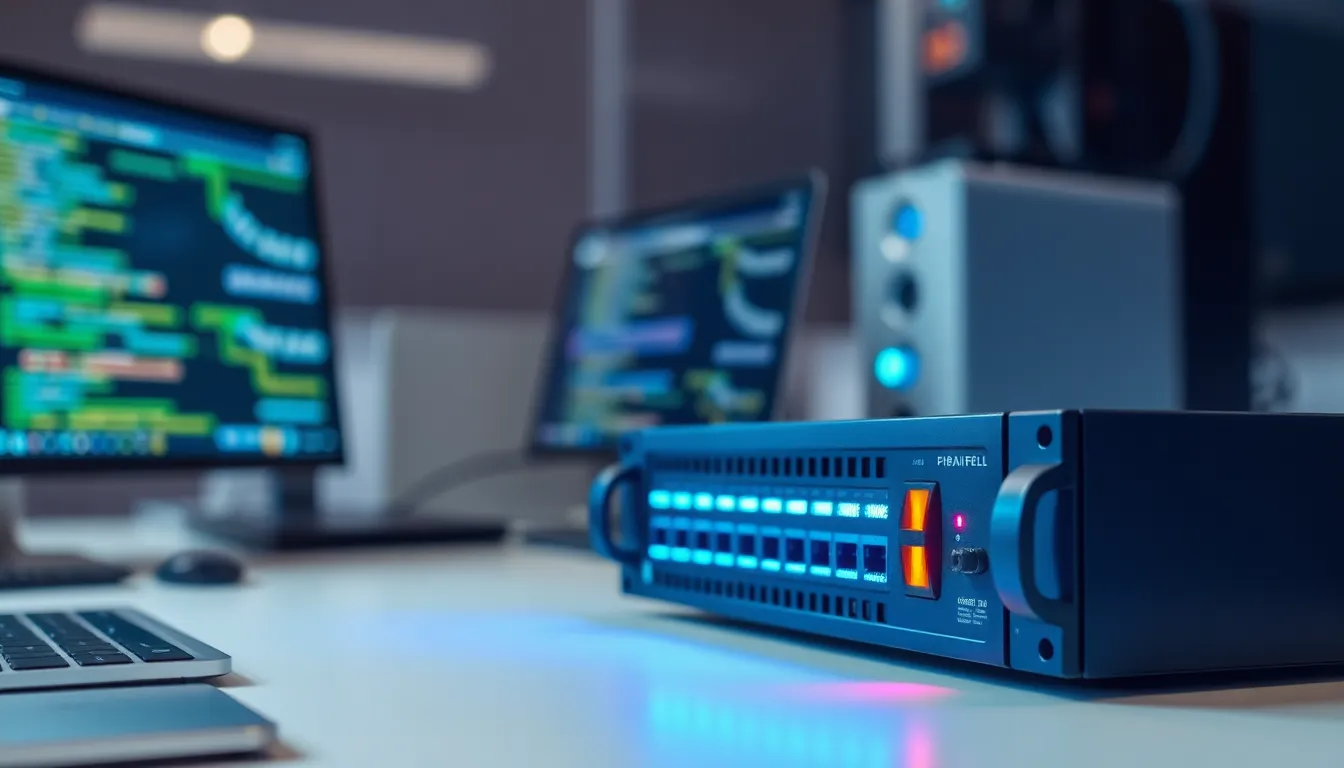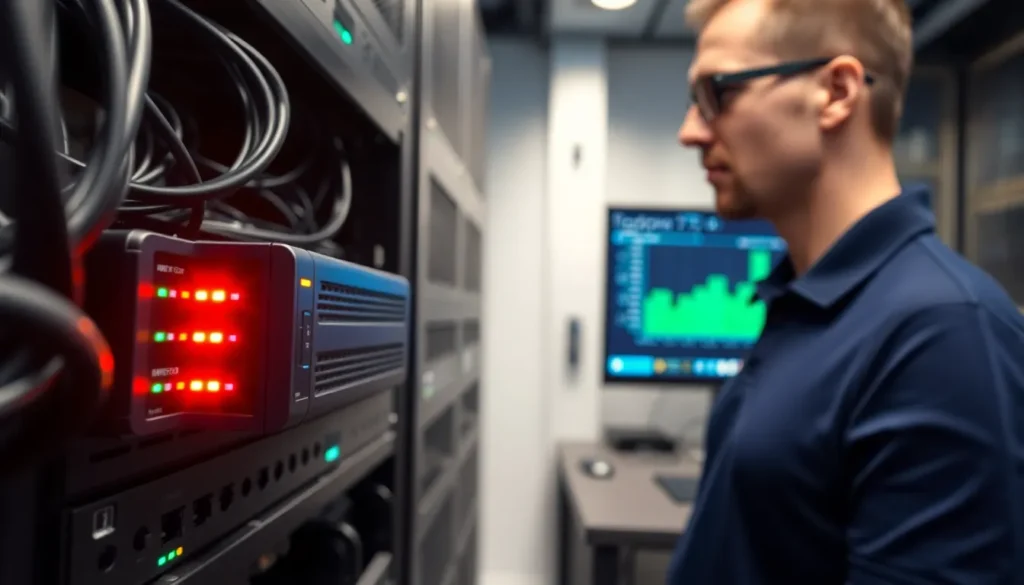Table of Contents
ToggleIn a world where cyber threats lurk behind every digital corner, cybersecurity hardware is the unsung hero ready to save the day. Imagine your data as a juicy steak and hackers as a pack of ravenous wolves. Without the right hardware, that steak won’t stand a chance. From firewalls that act like a fortress to intrusion detection systems that sniff out trouble faster than a bloodhound, the right tools can make all the difference.
Overview of Cybersecurity Hardware
Cybersecurity hardware includes various devices designed to safeguard digital assets from cyber threats. Firewalls play a significant role by controlling incoming and outgoing network traffic based on predetermined security rules. Intrusion detection systems (IDS) monitor network traffic for suspicious activity, alerting administrators of potential breaches.
Next, hardware security modules (HSMs) manage and safeguard digital keys used for encryption, offering a secure environment for cryptographic operations. Routers equipped with built-in security features can prevent unauthorized access while allowing legitimate users to connect safely. Additionally, physical access control systems restrict entry to sensitive areas, ensuring that only authorized personnel can reach critical hardware.
Moreover, data loss prevention (DLP) appliances monitor and manage sensitive information transmissions to prevent data breaches. Secure web gateways filter unwanted software from web traffic, providing an additional layer of protection. Antivirus hardware solutions actively scan for and neutralize malware threats, keeping systems safe from infections.
Understanding the specific functionalities of cybersecurity hardware can significantly enhance a user’s ability to protect essential data. Organizations benefit from implementing a combination of these devices to create a robust security infrastructure that minimizes vulnerability.
Types of Cybersecurity Hardware

Cybersecurity hardware encompasses several critical components that enhance data protection. Each device plays a unique role in securing networks and safeguarding sensitive information.
Firewalls
Firewalls act as barriers between internal networks and external threats. They filter incoming and outgoing traffic based on pre-set security rules. Organizations may deploy hardware firewalls to monitor traffic at the network perimeter or use software-based firewalls for endpoint protection. Firewalls help block unauthorized access, ensuring only legitimate users can connect. By analyzing data packets, these devices prevent potential attacks and reduce the risk of data breaches.
Intrusion Detection Systems
Intrusion detection systems (IDS) continuously monitor network traffic for suspicious activity. They analyze patterns to identify potential threats and alert administrators. Intrusion prevention systems (IPS), a subset of IDS, take immediate action against detected threats. Implementing IDS provides real-time visibility into network security, allowing for prompt responses. Alerts sent by these systems can be crucial for mitigating risks associated with unauthorized access or data exfiltration.
Encryption Devices
Encryption devices play a vital role in securing sensitive information. They encrypt data to protect it from unauthorized access during storage and transmission. Hardware security modules (HSMs) manage and protect encryption keys, providing a controlled environment for cryptographic processes. Various organizations utilize encryption appliances to ensure compliance with data protection regulations. In addition, these devices safeguard data integrity and confidentiality, forming a core part of a comprehensive cybersecurity strategy.
Benefits of Using Cybersecurity Hardware
Cybersecurity hardware offers numerous advantages that enhance digital security. First, firewalls serve as critical barriers, effectively blocking unauthorized traffic and protecting internal networks. When organizations implement firewalls, they establish a first line of defense against external threats.
Intrusion detection systems actively monitor network traffic, providing real-time alerts regarding suspicious activities. These systems help administrators respond quickly to potential threats, minimizing damage. Moreover, intrusion prevention systems take it a step further by automatically mitigating detected threats, ensuring immediate action.
Encryption devices play a vital role in safeguarding sensitive information. By encrypting data during storage and transmission, these devices reduce the risk of unauthorized access. Organizations using encryption maintain compliance with data protection regulations, fostering trust among customers.
Hardware security modules protect encryption keys, preserving data integrity and confidentiality. They ensure that sensitive keys remain secure, shielding crucial data from cybercriminals. Implementing HSMs enhances overall security posture significantly.
Employing a combination of these devices strengthens an organization’s security infrastructure. This integrated approach minimizes vulnerabilities associated with digital threats. Ultimately, investing in cybersecurity hardware not only protects data but also supports business continuity and reputational integrity. Integrating robust security measures creates a more resilient atmosphere against cyber threats.
Considerations When Choosing Cybersecurity Hardware
Selecting the right cybersecurity hardware involves several crucial factors. Performance capabilities matter; hardware must handle peak traffic without introducing latency. Reliability is vital; well-known brands often provide more dependable support and updates.
Compatibility with existing systems ensures seamless integration. Check for certifications that comply with industry standards, as this demonstrates adherence to best practices. Scalability also plays a significant role; choose hardware that can grow with an organization’s expanding needs.
Cost considerations should align with budgetary constraints, but prioritize value over price alone. Support options are essential; hardware that includes professional services can simplify deployment and maintenance. Warranty terms offer additional peace of mind, ensuring protection over an extended period.
Consider the specific environment in which the hardware will operate. Environmentally resistant devices might be necessary for locations with extreme temperatures or humidity. User-friendliness can ease training and operational challenges; opt for intuitive interfaces that simplify task management.
Vendor reputation also influences decisions; trusted manufacturers often provide reliable and secure products. Review customer testimonials and expert evaluations to gather insights. Sensor capabilities are important as well; advanced detection features enhance threat identification and response times.
Incorporating diverse devices creates a layered security approach, improving overall defense. Firewalls, IDS, and HSMs together fortify the infrastructure. Careful evaluation of these factors ensures an organization selects the most effective cybersecurity hardware to protect against evolving cyber threats.
Future Trends in Cybersecurity Hardware
Advancements in cybersecurity hardware are reshaping the landscape. Next-generation firewalls increasingly integrate artificial intelligence (AI) for enhanced threat detection. AI algorithms analyze traffic patterns and identify anomalies, improving response times to evolving threats.
Quantum computing represents another significant shift. This technology poses a challenge to traditional encryption methods, driving the development of quantum-resistant algorithms. Organizations prioritize their transition to hardware capable of handling these new encryption standards to ensure data security.
Moreover, the Internet of Things (IoT) expands the threat surface. With more devices connected, cybersecurity hardware must address the unique vulnerabilities of IoT ecosystems. Solutions now focus on securing these devices through specialized gateway systems and intrusion detection mechanisms tailored for IoT environments.
Edge computing is a rising trend as well. As data processing occurs closer to where it is generated, real-time data analysis becomes possible. Hardware designed for edge environments enhances response times and mitigates latency issues associated with centralized data processing.
Sustainability in hardware production is gaining attention. Environmentally conscious manufacturing processes are increasingly linked to hardware development. Consumers expect devices that are not only effective but also environmentally friendly, prompting manufacturers to adopt sustainable practices.
Lastly, modular hardware solutions are emerging. These allow organizations to customize their security infrastructure based on specific needs. Flexibility in adapting to new threats while optimizing costs positions modular systems as a favored choice for businesses navigating complex security challenges.
Investing in cybersecurity hardware is essential for safeguarding data against an ever-evolving landscape of cyber threats. By implementing a combination of firewalls, intrusion detection systems, and encryption devices, organizations can significantly enhance their security posture. The importance of selecting the right hardware cannot be overstated, as it directly impacts the effectiveness of an organization’s defenses.
As technology advances, staying informed about trends such as AI integration and quantum-resistant encryption becomes crucial. Embracing these innovations allows businesses to adapt to new challenges while ensuring compliance and protecting sensitive information. Ultimately, a proactive approach to cybersecurity hardware not only minimizes vulnerabilities but also fosters trust and confidence in an organization’s commitment to data protection.







